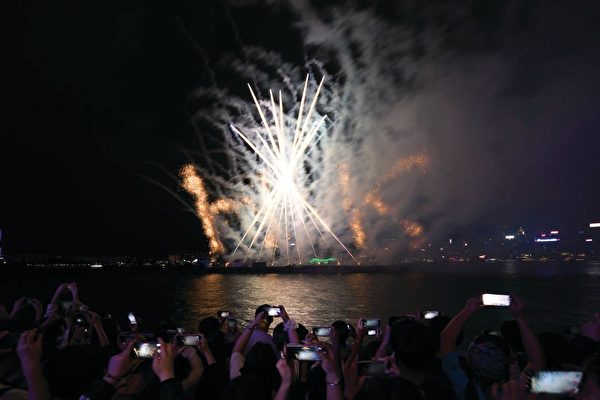Authorities set off fireworks near the sea in Tsim Sha Tsui on the evening of May 1, but many citizens and tourists who watched the display criticized that they were covered by smoke and could not see the performance clearly. Legislative Council member Jiang Yuhuan also questioned the effectiveness of the 10-minute fireworks display on the Hong Kong economy and raised concerns about whether fireworks should be set off every other month in the future.
The fireworks started at 8 p.m. and lasted for 10 minutes, shorter than the 12 and 23 minutes for the fireworks during New Year’s Eve and Chinese New Year, respectively. The Secretary for Home Affairs Ronald Yeung Wun-hong posted on Facebook the night before the fireworks display, wishing “holidaymakers a happy holiday in Hong Kong.” However, many mainland Chinese netizens criticized the display on platforms like “Xiaohongshu,” expressing disappointment and feeling deceived. They pointed out that the smoke during the performance did not dissipate, and they could not see the “HK” characters that were supposed to be visible.
Some mainland netizens described the scale of the fireworks as “at the level of a self-organised citizen event” and labeled the experience of watching fireworks as “a day of being deceived.” Some even bluntly stated that it was “a gimmick to lure tourists to spend money.”
On the night after the fireworks display, at 10 p.m., Jiang Yuhuan observed that Tsim Sha Tsui was deserted, questioning the economic impact of a 10-minute fireworks display on Hong Kong and whether fireworks should indeed be set off every other month in the future. She noted a decrease in the number cars queuing at parking lots in areas like Tsim Sha Tsui and Causeway Bay and observed a significant influx of people crossing the border between Hong Kong and Shenzhen.
Jiang went on to discuss the trend of Hong Kong residents traveling to mainland China for shopping, pointing out that as the May 1 holiday approached, Shenzhen businesses swiftly messaged Hong Kong customers on WeChat to attract them for shopping trips in Shenzhen. She raised concerns about whether new stores opening in Hong Kong cater to local customers and questioned if Hong Kong is becoming too similar to Shenzhen with the influx of mainland Chinese brand restaurants and retail stores. She emphasized the importance of telling Hong Kong’s unique story to attract visitors.
Drawing examples from towns and cities in Spain, Germany, and Italy, where each has its own distinct characteristics and diverse shops, she emphasized that tourists are interested in exploring unique establishments. She suggested that Shenzhen merchants have successfully targeted the right audience and utilized effective sales tactics, making shopping enjoyable for Hong Kong customers in Shenzhen and enabling Shenzhen tourists to freely explore the city through public transport. In contrast, she criticized Hong Kong for relying heavily on package tours, likening the situation to the 1980s.
Jiang argued that Hong Kong lacks the capacity to compete with Shenzhen for similar customer groups and proposed actively attracting business and international clientele. Citing an example of a woman she met on a high-speed railway train who visited Hong Kong specifically for a gift exhibition, Jiang believed that Hong Kong should focus on such aspects.
The Immigration Department had earlier estimated that there would be one million entries and exits on May 1, but the actual figures showed 808,000, with Hong Kong residents accounting for approximately 454,000, mainland visitors around 301,000, and other visitors about 52,600.
The Executive Director of the Travel Industry Council, Jason Kwai Ting-pong, stated on a radio program that hotel occupancy rates were satisfactory. He acknowledged that hotel prices in Shenzhen are cheaper than in Hong Kong, and with the current convenient transportation between Hong Kong and mainland China, visitors choose to stay in the mainland before returning to Hong Kong the next day.
He considered the number of mainland visitors to Hong Kong to be ideal, similar to the previous year, and believed that the numbers would have been higher if not for the weather conditions. He also noted that some visitors may not opt to visit Hong Kong on the first day of the holiday, and Hong Kong residents traveling to mainland China during the holidays is a normal occurrence.

